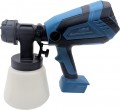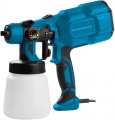Type
The type is indicated by the energy source from which the spray gun operates. Nowadays, you can find
pneumatic,
electric(mains and
battery), as well as
mechanical and
gasoline models. Here are their main features:
— Pneumatic. Spray guns powered by compressed air from an external compressor. In other words, the delivery package for such a tool includes only a spray gun (gun, airbrush, etc.); it requires a separate compressor to operate. At first glance, this creates certain inconveniences; however, such a configuration also has noticeable advantages. Firstly, there is no need to overpay for a compressor if it is already “on the farm” (a separate example of such a situation is a construction site where a powerful stationary compressor is used for several pneumatic tools). Secondly, the nozzle and compressor can be selected at your own discretion, without relying on the equipment selected by the manufacturer. In light of this, most modern spray guns are made pneumatic. The obvious disadvantages of such devices include their unsuitability for working with airless spray systems, however, such systems are used much less frequently than air systems, so this nuance is not key.
- Electric. In this case, we mean wall-powered spray guns (battery-powered models are placed in a separate category,
...see below). Devices of this type consist of the sprayer itself, as well as a compressor (built-in or remote). One of the advantages of this option is the presence of a compressor, thanks to which such a spray gun, in fact, only needs an outlet. In addition, such units can use both air and airless spray systems. The disadvantages of electric models include a higher cost than pneumatic ones, as well as the inability to select a working nozzle and a compressor separately - as a rule, spray guns of this type are sold in ready-made kits.
- Rechargeable. Spray guns equipped with electric compressors powered by their own batteries. The key advantage of such tools is their autonomy, the ability to work even in the absence of sockets nearby. On the other hand, it is difficult to achieve high power and performance with a battery; the continuous operation time of such sprayers is limited by the battery charge (and a source of electricity will still be required to replenish the charge); and the design itself is more complex and more expensive than that of analogues powered from an outlet. Therefore, cordless spray guns are not particularly widespread in our time.
- Mechanical. Units in which paint is supplied by the user’s muscular strength - in other words, to do this, you need to manually pump the pump lever. This operating scheme is as simple and reliable as possible, but it is poorly suited for traditional sprayers. Therefore, “mechanics” is extremely rare in our time, mainly among rollers (see “View”).
- Gasoline. Models with this type of power supply combine high power and independence from electrical networks, but they are quite bulky, more complex to operate and repair, more expensive (both in terms of their own cost and the price of fuel) and are generally designed for industrial use outdoors . Therefore, they are not widely used and are used where, for one reason or another, electrical analogues are not applicable.Power consumption
The power consumed by the operation of an electric tool (see "Type").
Most modern spray guns, even performant ones, have a rather low power: for example, models
with more than 1 kW are extremely rare, and in most cases, power consumption does
not exceed 500 W at all. So when connecting such equipment to sockets, there are usually no problems; only single units of high performance, requiring 3.5 kW or more, have to be connected according to special rules (directly to the shield). In other cases, data on power consumption is most often not needed for normal use and may be required only for specific tasks — for example, to calculate the load on an autonomous generator.
Air consumption
Nominal air flow rate when the spray gun is operating in normal mode.
This parameter is of key importance for a pneumatic tool (see "Type"): the compressor to which such a sprayer is connected must provide the appropriate air supply rate, otherwise normal operation will not be possible. In turn, in electric models, this indicator is more of a reference — the complete compressor, by definition, corresponds to the characteristics of the sprayer, and it makes sense to pay attention to the flow rate only if the working nozzle of the electric spray gun is planned to be used with a "non-native" compressor.
Paint consumption
Consumption of paint or other material (for example, mortar for plaster) when the spray gun is operating in normal mode.
The higher the flow rate, the more material the tool can apply per unit of time, the better it is suitable for processing large areas and for applying thick coatings. On the other hand, not all types of work require high productivity, and sometimes relatively low consumption is optimal. Detailed recommendations on this subject for different situations can be found in special sources.
Maximum viscosity
The maximum viscosity of the paint or other working material at which the spray gun is able to work normally. Specified in DIN units; a certain DIN in this case is the number of seconds it takes for a standard volume of paint (usually 100 mL) to pour out of a funnel with a strictly defined pour hole diameter (usually about 4 mm). Such a funnel (viscometer) can be supplied with the spray gun, but if necessary, it can be purchased separately.
Thus, the larger the DIN, the more viscous the composition is. And the larger the number indicated in the characteristics of the spray gun, the wider its capabilities, the thicker liquids can be poured into it without fear of clogging and breakage. At the same time, it should be taken into account that in fact it is not so often necessary to work with thick liquids — on the contrary, excessive viscosity worsens the quality of the coating, leads to streaks and increases the drying time. For example, most enamels and oil paints are used at a viscosity of about 20 DIN, latex paints up to 45 DIN, etc. General recommendations on this matter can be found in special sources, and specific ones can be found on the packaging of a particular brand of paint or other composition.
Nozzle size
The diameter of the nozzle at the outlet of the spray gun.
It is from this nozzle that paint or other working material comes out. And the productivity and spot size at the exit depend on the diameter. Accordingly, larger nozzles are better suited for processing large surfaces, while smaller nozzles provide greater precision and accuracy. Thus, this parameter is directly related to the type of device (see above). There are also
spray guns with a replaceable nozzle, when more than one nozzle is provided in the kit, which expands the possibilities of using the device.
Container volume
The total volume of the paint reservoir supplied with the gun.
Large tank, on the one hand, allows you to "charge" a lot of material and work for a long time. On the other hand, it increases the size and weight of the device; and a large amount of paint will also weigh accordingly (although for models with a separate tank location - see above - this is not critical). Therefore, the thinner and more delicate the work for which the spray gun is designed, the, as a rule,
the smaller the tank volume : for example, in airbrushes (see "View") it rarely exceeds 50 ml, and in plaster models, in turn, can be measured liters. Therefore, most models have a volume of no more than a liter, namely
500 ml,
600 ml,
700 ml,
800 ml,
1000 ml.

